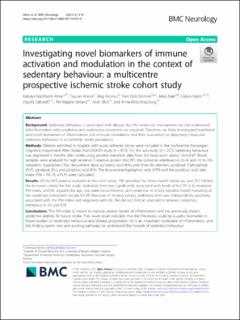| dc.description.abstract | Background
Sedentary behaviour is associated with disease, but the molecular mechanisms are not understood. Valid biomarkers with predictive and explanatory properties are required. Therefore, we have investigated traditional and novel biomarkers of inflammation and immune modulation and their association to objectively measured sedentary behaviour in an ischemic stroke population.
Methods
Patients admitted to hospital with acute ischemic stroke were included in the multicentre Norwegian Cognitive Impairment After Stroke (Nor-COAST) study (n = 815). For this sub-study (n = 257), sedentary behaviour was registered 3 months after stroke using position transition data from the body-worn sensor, ActivPal®. Blood samples were analysed for high sensitive C-reactive protein (hsCRP), the cytokines interleukin-6 (IL-6) and 10 (IL-10), neopterin, tryptophan (Trp), kynurenine (kyn), kynurenic acid (KA), and three B6 vitamers, pyridoxal 5′-phosphate (PLP), pyridoxal (PL), and pyridoxic acid (PA). The kynurenine/tryptophan ratio (KTR) and the pyridoxic acid ratio index (PAr = PA: PL + PLP) were calculated.
Results
Of the 815 patients included in the main study, 700 attended the three-month follow-up, and 257 fulfilled the inclusion criteria for this study. Sedentary time was significantly associated with levels of hsCRP, IL-6, neopterin, PAr-index, and KA adjusted for age, sex, waist circumference, and creatinine. In a fully adjusted model including all the significant biomarkers except hsCRP (because of missing values), sedentary time was independently positively associated with the PAr-index and negatively with KA. We did not find an association between sedentary behaviour, IL-10, and KTR.
Conclusions
The PAr-index is known to capture several modes of inflammation and has previously shown predictive abilities for future stroke. This novel result indicates that the PAr-index could be a useful biomarker in future studies on sedentary behaviour and disease progression. KA is an important modulator of inflammation, and this finding opens new and exciting pathways to understand the hazards of sedentary behaviour. | en_US |

